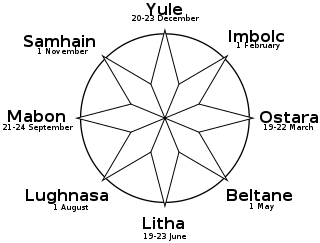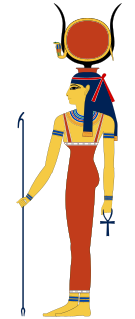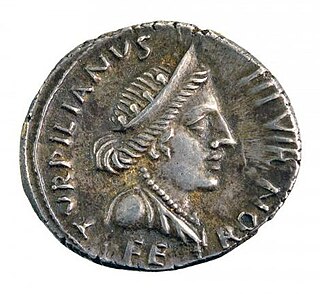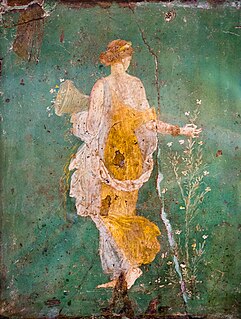Related Research Articles

In ancient Greek mythology and religion, Artemis is the goddess of the hunt, the wilderness, wild animals, nature, vegetation, childbirth, care of children, and chastity. She was heavily identified with Selene, the Moon, and Hecate, another Moon goddess, and was thus regarded as one of the most prominent lunar deities in mythology, alongside the aforementioned two. She would often roam the forests of Greece, attended by her large entourage, mostly made up of nymphs, some mortals, and hunters. The goddess Diana is her Roman equivalent.

The Wheel of the Year is an annual cycle of seasonal festivals, observed by many modern pagans, consisting of the year's chief solar events and the midpoints between them. While names for each festival vary among diverse pagan traditions, syncretic treatments often refer to the four solar events as "quarter days", with the four midpoint events as "cross-quarter days". Differing sects of modern paganism also vary regarding the precise timing of each celebration, based on distinctions such as lunar phase and geographic hemisphere.

In Roman religion, Angerona or Angeronia was an old Roman goddess, whose name and functions are variously explained. She is sometimes identified with the goddess Feronia.

Angitia was a goddess among the Marsi, the Paeligni and other Oscan-Umbrian peoples of central Italy. She was associated in antiquity with snake-charmers who claimed her as their ancestor. Roman interpretations probably obscure her Marsian significance.

Dea Dia was a goddess of fertility and growth in ancient Roman religion. She was sometimes identified with Ceres, and sometimes with her Greek equivalent Demeter.
Mellona or Mellonia was an ancient Roman goddess said by St. Augustine to promote the supply of honey as Pomona did for apples and Bubona for cattle. Arnobius describes her as "a goddess important and powerful regarding bees, taking care of and protecting the sweetness of honey."

In Aztec mythology, Chicomecōātl[t͡ʃikomeˈkoːaːt͡ɬ] "Seven Serpent", was the Aztec goddess of agriculture during the Middle Culture period. She is sometimes called "goddess of nourishment", a goddess of plenty and the female aspect of maize.

Hathor was a major goddess in ancient Egyptian religion who played a wide variety of roles. As a sky deity, she was the mother or consort of the sky god Horus and the sun god Ra, both of whom were connected with kingship, and thus she was the symbolic mother of their earthly representatives, the pharaohs. She was one of several goddesses who acted as the Eye of Ra, Ra's feminine counterpart, and in this form she had a vengeful aspect that protected him from his enemies. Her beneficent side represented music, dance, joy, love, sexuality, and maternal care, and she acted as the consort of several male deities and the mother of their sons. These two aspects of the goddess exemplified the Egyptian conception of femininity. Hathor crossed boundaries between worlds, helping deceased souls in the transition to the afterlife.

Shaktism is one of several major Hindu denominations, wherein the metaphysical reality is considered metaphorically a woman and Shakti (Mahadevi) is regarded as the supreme godhead. It includes many goddesses, all considered aspects of the same supreme goddess. Shaktism has different sub-traditions, ranging from those focused on most worshipped Durga, gracious Parvati to that of fierce Kali.

Astarte is the Hellenized form of the Ancient Near Eastern goddess Ashtart or Athtart, a deity closely related to Ishtar, who was worshipped from the Bronze Age through classical antiquity. The name is particularly associated with her worship in the ancient Levant among the Canaanites and Phoenicians, though she was originally associated with Amorite cities like Ugarit and Emar, as well as Mari and Ebla. She was also celebrated in Egypt, especially during the reign of the Ramessides, following the importation of foreign cults there. Phoenicians introduced her cult in their colonies on the Iberian Peninsula.

In ancient Roman religion, Feronia was a goddess associated with wildlife, fertility, health, and abundance. As the goddess who granted freedom to slaves or civil rights to the most humble part of society, she was especially honored among plebeians and freedmen. Her festival, the Feroniae, was November 13 during the Ludi Plebeii, in conjunction with Fortuna Primigenia; both were goddesses of Praeneste.

Flora is a Roman goddess of flowers and of the season of spring – a symbol for nature and flowers. While she was otherwise a relatively minor figure in Roman mythology, being one among several fertility goddesses, her association with the spring gave her particular importance at the coming of springtime, as did her role as goddess of youth. She was one of the fifteen deities who had their own flamen, the Floralis, one of the flamines minores. Her Greek counterpart is Chloris.

In Roman mythology, Voluptas or Volupta is the daughter born from the union of Cupid and Psyche, according to Apuleius. The Latin word voluptas means 'pleasure' or 'delight'; Voluptas is known as the goddess of "sensual pleasures". She is often found in the company of the Gratiae, or Three Graces.

Artemisa is a municipality and city in Cuba, formerly part of La Habana Province. According to a law approved by the Cuban National Assembly in August 2010, Artemisa became the capital city of the newly formed Artemisa Province, which comprises eight municipalities of the former La Habana Province and three from Pinar del Río. It has an area of 642.0 square kilometers and a population of over 85,000 inhabitants (2017).

Angerona is a monotypic moth genus in the family Geometridae erected by Philogène Auguste Joseph Duponchel in 1829. Its only species, Angerona prunaria, the orange moth, was first described by Carl Linnaeus in his 1758 10th edition of Systema Naturae.

In ancient Roman religion, Bubona is thought to have been a goddess of cattle, but she is named only by Saint Augustine.

Kali Puja, also known as Shyama Puja or Mahanisha Puja, is a festival, originating from the Indian subcontinent, dedicated to the Hindu goddess Kali, celebrated on the new moon day of the Hindu calendar month of Ashwayuja or Kartika. It is especially celebrated in the regions of West Bengal, Mithila, Odisha, Assam, and Tripura, and the neighbouring country Bangladesh.
The gens Ancharia was a plebeian family at ancient Rome. The first of the gens to achieve prominence was Quintus Ancharius, a senator early in the first century BC.
Angerona is an unincorporated community in Jackson County, West Virginia, United States.
References
- 1 2 The Mirror of Literature, Amusement, and Instruction, 1828, p. 346
- ↑ Chisholm, Hugh, ed. (1911). "Angerona". Encyclopædia Britannica . Vol. 2 (11th ed.). Cambridge University Press. p. 8.
![]() This article incorporates text from a publication now in the public domain : Chambers, Ephraim, ed. (1728). Cyclopædia, or an Universal Dictionary of Arts and Sciences (1st ed.). James and John Knapton, et al.
This article incorporates text from a publication now in the public domain : Chambers, Ephraim, ed. (1728). Cyclopædia, or an Universal Dictionary of Arts and Sciences (1st ed.). James and John Knapton, et al.{{cite encyclopedia}}: Missing or empty |title= (help)